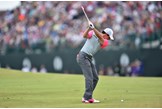Rory’s swing: Down the line
Published: Last updated:
Woburn head pro Luther Blacklock analyses the swing of the 2011 US Open and 2012 US PGA champion, and newly crowned 2014 Open champion.
When Tiger Woods came out on Tour in 1996, he blew the dominant golfers of the time, like Ernie Els and Colin Montgomerie, away with his sheer power and athleticism. However, while Els and Monty never fully recovered from the mental batterings they received at the hands of Woods, Rory – who grew up idolising Tiger – never feared him.
Although different people, Woods and McIlroy have much in common. Like Woods McIlroy was a childhood prodigy, shooting 61 off the tips at Portrush when just 14. Though not as tall as Tiger, McIlroy also has the ideal frame for generating huge clubhead speed, and in many respects represents the next generation of player – guys who have adopted Tiger’s ferocious power and adapted it to their game. Modern club and ball technologies have also helped make such power hitting more controllable than ever.
But while Tiger is known for his high level of consistency, Rory is much more of a streaky, flair player. In this article, we’ll examine the swing idiosyncrasies that make it difficult for him to play his best golf all of the time.

Down-the-line analysis
At address
Rory creates good, clean angles with his posture. However, his chin is a fraction too low and tucked into his chest, and his right arm is a little too straight. With most top players, you tend to see a ‘softening’ of the right elbow towards the right hip which will afford a glimpse of the left foream from this angle. But that’s not the case with Rory here.
The takeaway
Rory’s relatively straight right arm at address is maintained into the early part of his takeaway with the result that the clubhead remains outside of his hands. It’s almost as if his extended right arm is obstructing the natural path of the swing. From here, he will have to employ a very late wrist hinge to get the club back on to the ideal plane.
At the top
Rory’s top of the backswing is not what you would call ‘classic’. He has gone from slightly above plane in the previous frame to slightly below plane here. Because of the lack of room between his chin and his chest, Rory’s backswing lacks the comfortable fluidity of, say, an Adam Scott. A few small tweaks to his set-up would quickly fix this problem.
Starting down
If you cut off Rory’s head in this image, it would be hard to tell him apart from Sergio Garcia. Rory’s backswing has been slightly compromised by his low chin and straight right arm, which means a degree of volatility is required to get him back on plane. See how he is losing height as he compresses down into the ground.
Impact
Compare Rory’s height in this image with the previous frame. You very much get the sense here that his whole body is now rising again to meet the ball. The left forearm is now visible from this angle, showing that Rory’s immense talent has enabled him to find a way of powerfully delivering the club to the ball despite its rather circuitous journey.
The finish
And finally we achieve perfect orthodoxy as Rory rapidly clears his hips through impact and freewheels into a balanced and comfortable followthrough. All of Rory’s immense talent, power and flexibility are on display here as his chest points to the left of the target and the weight rolls onto the outside of his left foot.

